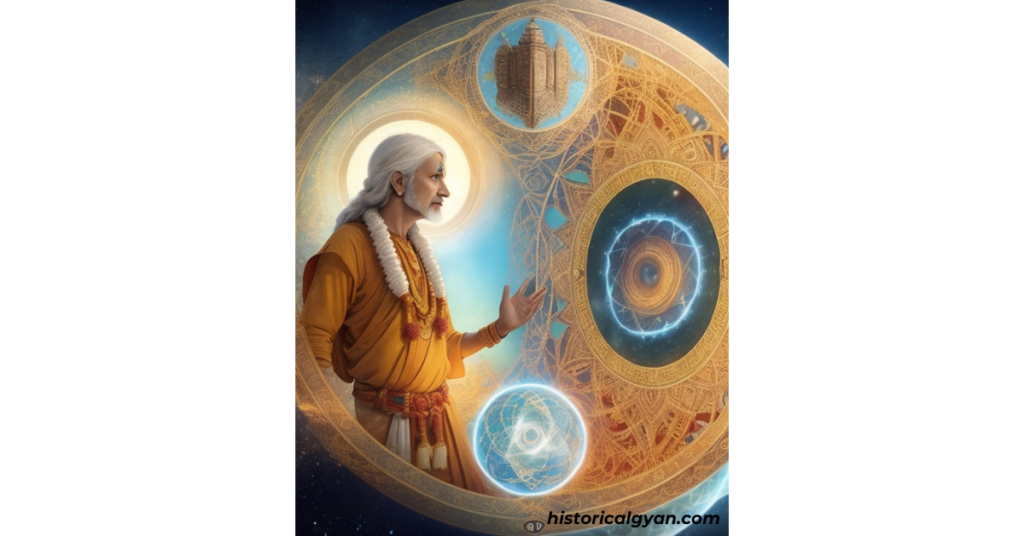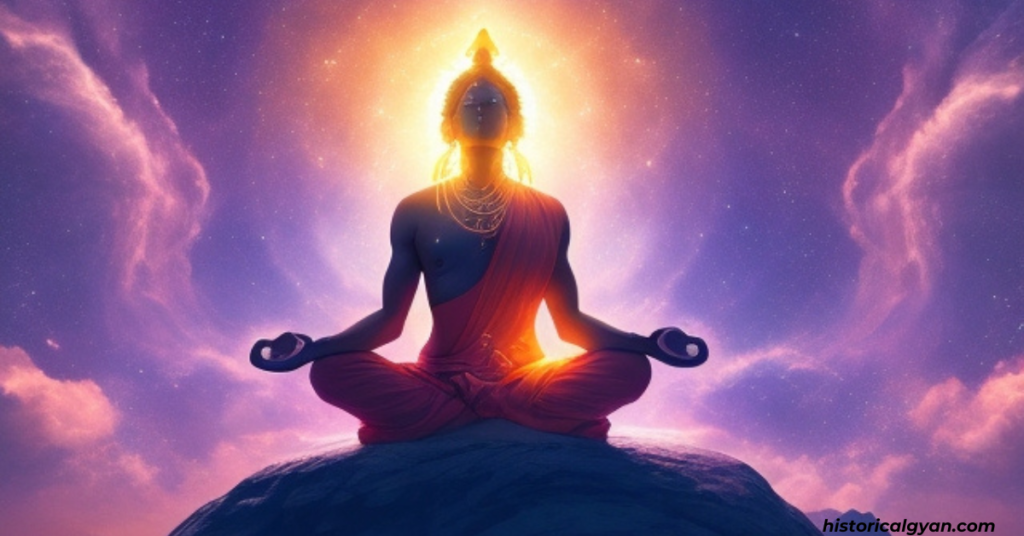The difference between present knowledge society and Vedic knowledge society
In the tapestry of human history, the interwoven threads of science and spirituality have shaped our collective understanding. The intricate relationship between these realms, exemplified through practices like yoga and Vedanta, offers a unique vantage point to discern which is the difference between present knowledge society and Vedic knowledge society. This comprehensive exploration aims to shed light on the distinctive facets of these societies while underscoring the timeless wisdom intrinsic to Vedic knowledge.

Bridging Logic and Spirituality
Throughout history, spirituality has been perceived as a profound science, intricately woven with logic and empirical inquiry. The Vedic knowledge society, deeply rooted in the practices of yoga and meditation, harnessed these principles to empower seekers to attain direct experiential insights into the nature of reality. This fusion of scientific inquiry and spiritual exploration sets the stage for discerning the differences between the present knowledge society and the Vedic knowledge society.
Essence of Vedic Wisdom
The etymology of the term “Veda” finds its origins in the Sanskrit root “vidvan,” signifying “to know, see, or recognize.” The Vedas, often referred to as “Vidya,” encapsulate the concepts of knowledge and perception. Picture the Vedas as a projection of the wisdom of rishis (sages) onto the canvas of the contemplative mind. These rishis, in their profound insights, glimpsed the universal essence through the lens of Brahman, a principle that encompasses the very fabric of existence.

Veda Dharma: Holistic Knowledge
Veda Dharma, the cosmic laws governing the universe, extends its reach beyond the realm of physical matter and energy, encompassing domains such as life, mind, and self. In this expansive context, the Vedas emerge as a comprehensive repository of knowledge, rivaling even modern scientific paradigms. The journey into Vedic science reveals a diverse array of subjects, ranging from astronomy and chemistry to psychology and surgery. The Vedas embrace fields such as astrology and yogic science, offering insights into both the spiritual and material dimensions, thus reflecting a holistic approach to comprehending the world.
Revelation of Dual Wisdom
Within the pages of the Mundika Upanishad, a dichotomy between two forms of wisdom becomes apparent: higher knowledge and lower knowledge. The pursuit of higher knowledge leads to an understanding of the eternal, while the exploration of lower knowledge delves into the transient principles embodied by Naam, Rup, and Kriya Darshana. Vedanta’s conceptualization of reality is rooted in this division, highlighting the eternal and the transitory. India’s historical emphasis on internal or spiritual science, coupled with its engagement with external sciences, exemplifies a harmonious coexistence between the two.
| Aspect | Higher Knowledge | Lower Knowledge |
|---|---|---|
| Description | Leads to understanding the eternal | Explores transient principles (Naam, Rup, Kriya Darshana) |
| Conceptualization | Rooted in Vedanta’s perspective | Emphasizes Vedanta’s division of reality |
| Significance | Grasps the timeless essence | Engages with the transitory nature |
| Impact | Connects with the eternal | Explores the impermanent |
| Relation to India’s History | Aligns with India’s spiritual focus | Demonstrates coexistence of internal and external sciences |
Unified Vision of Science
A distinctive aspect of Vedic knowledge is the absence of a rigid demarcation between internal and external sciences. In the Vedic worldview, even external sciences like physics can serve as a spiritual path or a form of yoga when directed towards universal oneness and a deeper connection with oneself and the cosmos. This unique perspective positions various disciplines, including astrology, mathematics, music, and grammar, as manifestations of yoga or spiritual paths. The Vedic tradition historically nurtured both inner and outer sciences simultaneously, thereby illustrating the interconnectedness that underpins the unity of these fields.

Vedic and Modern Science: A Symbiotic Relationship
Remarkably, modern scientific principles align with certain facets of Vedic wisdom, dispelling the notion that spirituality hindered the advancement of external science in India’s history. This parallelism underscores the compatibility between the pursuit of spiritual insights and scientific progress. Historical circumstances, such as foreign invasions during the Dark Ages from 1000 AD to 1800 AD, may have impeded India’s scientific progress, but they did not diminish the profound impact of Vedic knowledge on shaping human understanding.
Embracing Vedic Wisdom in the Contemporary Era
In the present age, India is experiencing a resurgence of scientific minds deeply rooted in its cultural heritage. This resurgence involves scholars and scientists harmonizing ancient wisdom with modern insights, bridging the gap between Yoga, Vedanta, Buddhism, and contemporary scientific understanding. The convergence of diverse streams of knowledge fosters a holistic and inclusive approach to unraveling the mysteries of existence.

In conclusion, the difference between present knowledge society and Vedic knowledge society reveals threads that intertwine across time. The Vedic tradition’s ability to harmonize science and spirituality, its recognition of a unified reality, and its integration of various disciplines offer a profound lens through which we can explore the depth of human understanding.
Frequently Asked Questions (FAQs)
1. What are the main differences between the present knowledge society and the Vedic knowledge society?
Ans: The current knowledge society is characterized by modern scientific advances, while the Vedic knowledge society integrates ancient knowledge and spirituality, thereby promoting holistic understanding.
2. How does the Vedic Knowledge Society define high and low knowledge?
Answer: Higher knowledge leads to the understanding of the eternal, while lower knowledge searches for transient principles. This difference shapes Vedanta’s concept of reality.
3. What are the practical implications of uniting reason and spirituality in the Vedic knowledge society?
Answer: Fusion empowers seekers to experience Truth directly, aligning scientific inquiry with spiritual exploration for a comprehensive understanding of existence.
4. What subjects come under Vedic science?
Ans: Vedic science covers such diverse fields as astronomy, chemistry, psychology and surgery, which combine both physical and spiritual dimensions.
5. How has India’s historical emphasis on internal and external science shaped its scientific progress?
Ans: India’s harmonious coexistence between internal (spiritual) and external science promoted balanced development, despite historical disruptions.
6. How does the Vedic knowledge society influence the contemporary era?
Ans: In the modern era, India is witnessing a resurgence of scientific minds, promoting a holistic approach to knowledge, harmonizing ancient knowledge and modern insights.
7. How does modern science reconcile with Vedic principles?
Answer: Modern scientific advances often correspond to certain aspects of Vedic knowledge, thereby dispelling the misconception that spirituality hinders scientific progress.
8. What role does spirituality play in shaping the Vedic knowledge society?
Answer: Spirituality serves as the foundation of Vedic knowledge, filling it with a profound sense of meaning and purpose that enriches scientific understanding.
You can read this article of ours:- The True Meaning of Shivling

2 thoughts on “The difference between present knowledge society and Vedic knowledge society?| Importance of Vedic knowledge in modern age”